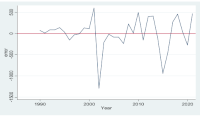Exchange Rate and Output in Nigeria (1986-2021)
Main Article Content
Abstract
Exchange rate as a major macroeconomic indicator was examined alongside output within the period (1986-2021) in Nigeria. With the ever rising exchange rate, indications are that certain drivers of the economy that should help create some balance are lacking. Secondary data were sourced from the CBN statistical bulletin for the said period and subjected to statistical inferential analysis using the Vector Autoregression (VAR) model. The major objective was to ascertain the relationship between exchange rate and output following coefficients like the unit root test, difference-stationary process, lag length criteria, stability condition check, Engel and Granger test as well as autocorrelation test. Results indicate that exchange rate indirectly affects output as a unit increase in it results in a corresponding unit decrease in output where at lag 2, there is a positive relationship affecting output directly, where any unit increase in exchange rate at those lags leads to a unit increase in output. Exchange rate based on the other VAR variables may not be used in predicting output as prob. of the chi2 coefficient for all were less than 0.05 hence output is adversely affected as various macroeconomic variables are at risk. The study discourages heavy reliance on mono-economy (oil exports) while diversification in the areas of agriculture and manufacturing will help cushion the effects of rising exchange rates and inflation in the country.
Downloads
Article Details
Section
How to Cite
Share
References
Adediran, J.Y. (2014). The impact of exchange rate fluctuation on the Nigerian economic growth: An empirical investigation. International Journal of Academic Research in Business and Social Sciences, pp.10.
Aliyu, S.U.R. (2010). Exchange rate volatility and export trade in Nigeria: An empirical investigation, applied financial Economics, 20(13), 1071-1084.
Central Bank of Nigeria (2020). CBN Economic Report, Abuja, FGP.
Christopher S. (1980), Macroeconomics and reality. Econometrica vol.48 (1),1 – 48.
Christopher, S., Stock, J. H. and Watson, M. W. (1990), Inference in linear time series models with some unit roots, Econometrica, vol.58 (1), 113 – 144
Ghura-David, J.B. (1991). Real exchange rate and macro-economic performance in sub Saharan Africa. Journal of Development Economics, 32, 155-174.
Granger, C. W. J., (1969), Investigating causal relations by econometric model and cross-spectral method, Econometrica, vol.37 (3), 424 – 438.
Gujarati, D. N. and Porter, D. C. (2009), Basic econometrics, 5th edition. McGraw Hill New York.Jhingan, M.I.(2009). Money, banking, international trade and public finance, Delhi. National Bureau of Statistics (2015). Foreign trade statistics (2nd quarter) 2015. Abuja, FGP.
Rapetti, M. (2012). The real exchange rate and economic growth are developing countries different, International Review of applied economics, Rutledge.
Rauff, S.A (2022). Determinants of Exchange rate in Nigeria. The colloquium- a multi disciplinary thematic policy Journal PP 69-82.
Stock, J. H. and Watson, M. W. (2001), Vector autoregression, Journal of Economic Perspective vol. 15 (4), 101 – 115.
Taylor, J.B. (2001). The role of the exchange rate in monetary policy rules. The American Economic Review, 91,2,263-267


